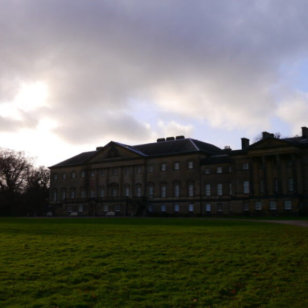The Newby-McMahon Building is in downtown Wichita Falls, Texas. It is 12 metres tall, and its exterior dimensions are 5.5 metres deep and 3.0 metres wide.

By Travis K. Witt (Own work) [CC BY-SA 4.0], via Wikimedia Commons
The building is the result of a fraudulent investment scheme in 1919.
A large oil field was discovered in Wichita County, Texas in 1912. Burkburnett and its surrounding communities became boomtowns, experiencing explosive growth of their populations and economies. By 1918, an estimated 20,000 new settlers had taken up residence around the lucrative oil field, and many Wichita County residents became wealthy virtually overnight.As people streamed into the local communities in search of high-paying jobs, the nearby city of Wichita Falls began to grow in importance. Though it initially lacked the necessary infrastructure for this sudden increase in economic and industrial activity, Wichita Falls was a natural choice to serve as the local logistical hub, being the seat of Wichita County. Because office space was lacking, major stock transactions and mineral rights deals were conducted on street corners and in tents that served as makeshift headquarters for the new oil companies.
As people streamed into the local communities in search of high-paying jobs, the nearby city of Wichita Falls began to grow in importance. Though it initially lacked the necessary infrastructure for this sudden increase in economic and industrial activity, Wichita Falls was a natural choice to serve as the local logistical hub, being the seat of Wichita County. Because office space was lacking, major stock transactions and mineral rights deals were conducted on street corners and in tents that served as makeshift headquarters for the new oil companies
The Newby-McMahon Building is a four-story brick building located near the railroad depot in downtown Wichita Falls, built in 1906 by Augustus Newby (1855–1909), a director of the Wichita Falls and Oklahoma City Railway Company. The oil-rig construction firm of J.D. McMahon, a petroleum landman and structural engineer from Philadelphia, was one of seven tenants whose offices were based in the original Newby Building.
According to local legend, when McMahon announced in 1919 that he would build a high-rise annexe to the Newby Building as a solution to the newly wealthy city’s urgent need for office space, investors were eager to invest in the project. McMahon collected $200,000 (approximately US$ 2,730,000 in 2016) in investment capital from this group of naive investors, promising to construct a highrise office building across the street from the St. James Hotel.
The key to McMahon’s swindle, and his successful defence in the ensuing lawsuit, was that he never verbally stated that the actual height of the building would be 150 metres. The proposed skyscraper depicted in the blueprints that he distributed (and which were approved by the investors) was clearly labelled as consisting of four floors and 480 inches (12 metres).
McMahon used his own construction crews to build the McMahon Building on the small, unused piece of property next to the Newby Building, without obtaining prior consent from the owner of the property, who lived in Oklahoma. As the building began to take shape, the investors
As the building began to take shape, the investors realised they had been swindled into purchasing a four-story edifice that was only 40 ft (12 m) tall, rather than the 480 ft (150 m) structure they were expecting. Not only is this is a far cry from the skyscrapers that make up many of today’s cityscapes such as the Shard in London it was also nowhere close to being a rival to the towers of the “First Great Age” such as the Woolworth Building at 792 ft (241 m).
They brought a lawsuit against McMahon but, to their dismay, the real estate and construction deal was declared legally binding by a local judge – as McMahon had built exactly according to the blueprints they had approved, there was to be no legal remedy for the deceived investors. They did recover a small portion of their investment from the elevator company, which refused to honour the contract. There was no stairway installed in the building upon its initial completion, as none was included in the original blueprints. Rather, a ladder was employed to gain access to the upper three floors. By the time construction was complete, McMahon had left Wichita Falls, taking with him the balance of the investors’ money.
[most of this text is from the Wikipedia entry – it was written very well!]


